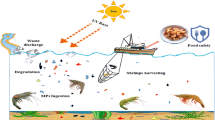Abstract
The in vitro effects of amorphous phenol and its liquid fractions formed 12 months after production were studied in seven freshwater bony fish species: the common carp Cyprinus carpio L., bream Abramis brama (L.), silver bream Blicca bjoerkna (L.), roach Rutilus rutilus (L.), perch Perca fluviatilis L., and sander Zander lucioperca (L.). The study revealed that the effects of amorphous phenol and its liquid fractions are species-specific and depend on the concentration of phenol and localization of peptidases (intestine mucosa or intestinal cavity in case of chyme). The specific features of the effect of amorphous phenol differ considerably from the effect of crystalline phenol.
Similar content being viewed by others
REFERENCES
Clayton, G.D. and Clayton, F.E., Patty’s Industrial Hygiene and Toxicology, New York: Wiley, 1994.
Flerov, B.A., Influence of low phenol concentrations on locomotor and foraging activity and increase in live weight of crucians, Vopr. Ikhtiol., 1965, vol. 5, no. 1 (34), pp. 164–167.
Flerov, B.A., Ekologo-fiziologicheskie aspekty toksikologii presnovodnykh zhivotnykh (Ecological and Physiological Aspects of Toxicology of Freshwater Animals), Leningrad: Nauka, 1989.
Flerova (Nazarova), E.A. and Zabotkina, E.A., Toxic effect of sublethal concentrations of phenol and naphthalene on Prussian carp mesonephros, Toksikol. Vestn., 2012, no. 4, pp. 49–51.
Ford, M.D., Delaney, K.A., Ling, L.J., and Erickson, T., Clinical Toxicology, Philadelphia: W.B. Saunders, 2001.
Goronovskii, I.T., Nazarenko, Yu.P., and Nekryach, E.F., Kratkii spravochnik po khimii (A Short Handbook on Chemistry), Kiev: Naukova dumka, 1987.
Jacob, F. and Monod, J., On the regulation of gene activity, Cold Spring Harbor Symp. Quant. Biol., 1961, vol. 26, pp. 193–211.
Kuz’mina, V.V., Tarleva, A.F., and Gracheva, E.L., Influence of various concentrations of phenol and its derivatives on the activity of fish intestinal peptidases, Inland Water Biol., 2017, vol. 10, no. 2, pp. 228–234.
Kuz’mina, V.V., Skvortsova, E.G., and Shalygin, M.V., Role of peptidases of the enteric microbiota and prey in temperature adaptations of the digestive system in boreal carnivorous fish, Inland Water Biol., 2019, vol. 12, no. 2, pp. 231–239.
Louvard, D., Maroux, S., Vannier, C., and Desnuelle, P., Topological studies on the hydrolases bound to the intestinal brush membrane. 1. Solubilization by papain and Triton X-100, Biochim. Biophys. Acta, 1975, vol. 375, no. 1, pp. 236–248.
Luk’yanenko, V.I., Toksikologiya ryb (Fish Toxicology), Moscow: Pishchevaya Promyshlennost’, 1967.
Luk’yanenko, V.I., Obshchaya ikhtiotoksikologiya (General Ichthyotoxicology), Moscow: Legkaya i Pishchevaya promyshlennost’, 1983.
Matei, V.E., Influence of subtoxic phenol concentrations on conditioned-reflex activity of guppies, Gidrobiol. Zh., 1970, vol. 6, no. 3, pp. 100–103.
Membrane Digestion. New Facts and Concepts, Ugolev, A.M., Ed., Moscow: Mir, 1989.
Michałowicz, J. and Duda, W., Phenols—sources and toxicity, Pol. J. Environ. Stud., 2007, vol. 16, no. 3, pp. 347–362.
Mikryakov, V.R., Balabanova, P.V., Zabotkina, E.A., Lapirova, T.B., Popov, A.V., and Silkina, N.I., Reaktsiya immunnoi sistemy ryb na zagryaznenie vody toksikantami i zakislenie sredy (The Response of the Immune System of Fish to Water Pollution by Toxicants and Acidification of the Environment), Moscow: Nauka, 2001.
Monod, J., Wyman, J., and Changeux, J.-P., On the nature of allosteric transitions: a plausible model, J. Mol. Biol., 1965, vol. 12, no. 1, pp. 88–118.
Sursyakova, V.V., Bondareva, L.G., Burmakina, G.V., and Rubailo, A.I., New approaches to identifying the sources of phenols entering surface water bodies, Dokl. Akad. Nauk, 2011, vol. 441, no. 6, pp. 767–770.
Tarleva, A.F., Sheptitskii, V.A., and Kuz’mina, V.V., Response of various systems of fish organism to phenol and its derivatives (overview), Probl. Biol. Produkt. Zhivotn., 2018, no. 4, pp. 27–44. https://doi.org/10.25687/1996-6733.prodanimbiol.2018.3.27-44
Ugolev, A.M., Membrannoe pishchevarenie. Polisubstratnye protsessy, organizatsiya i regulyatsiya (Membrane Digestion: Polysubstrate Processes, Organization, and Regulation), Leningrad: Nauka, 1972.
Waluga, D., Phenol-induced changes in the peripheral blood of the breams (Abramis brama L.), Acta Hydrobiol., 1966, vol. 8B, pp. 87–95.
Zaki, M.S., Fawzi, O.M., and Shalaby, S.I., Phenol toxicity affecting hematological changes in cat fish, Life Sci. J., 2011, vol. 8, no. 2, pp. 244–248.
Funding
This study was carried out within the framework of a State Assignment, project no. АААА-А18-118012690102-9.
Author information
Authors and Affiliations
Corresponding author
Ethics declarations
Conflict of interest. The authors declare that they have no conflict of interest.
Statement on the welfare of animals. All applicable international, national, and/or institutional guidelines for the care and use of animals were followed.
Additional information
Translated by D. Pavlov
Rights and permissions
About this article
Cite this article
Kuzmina, V.V., Tarleva, A.F. Influence of Amorphous Phenol and Its Fractions on the Activity of Fish Intestinal Peptidases. Biol Bull Russ Acad Sci 48, 172–176 (2021). https://doi.org/10.1134/S1062359021020072
Received:
Revised:
Accepted:
Published:
Issue Date:
DOI: https://doi.org/10.1134/S1062359021020072




